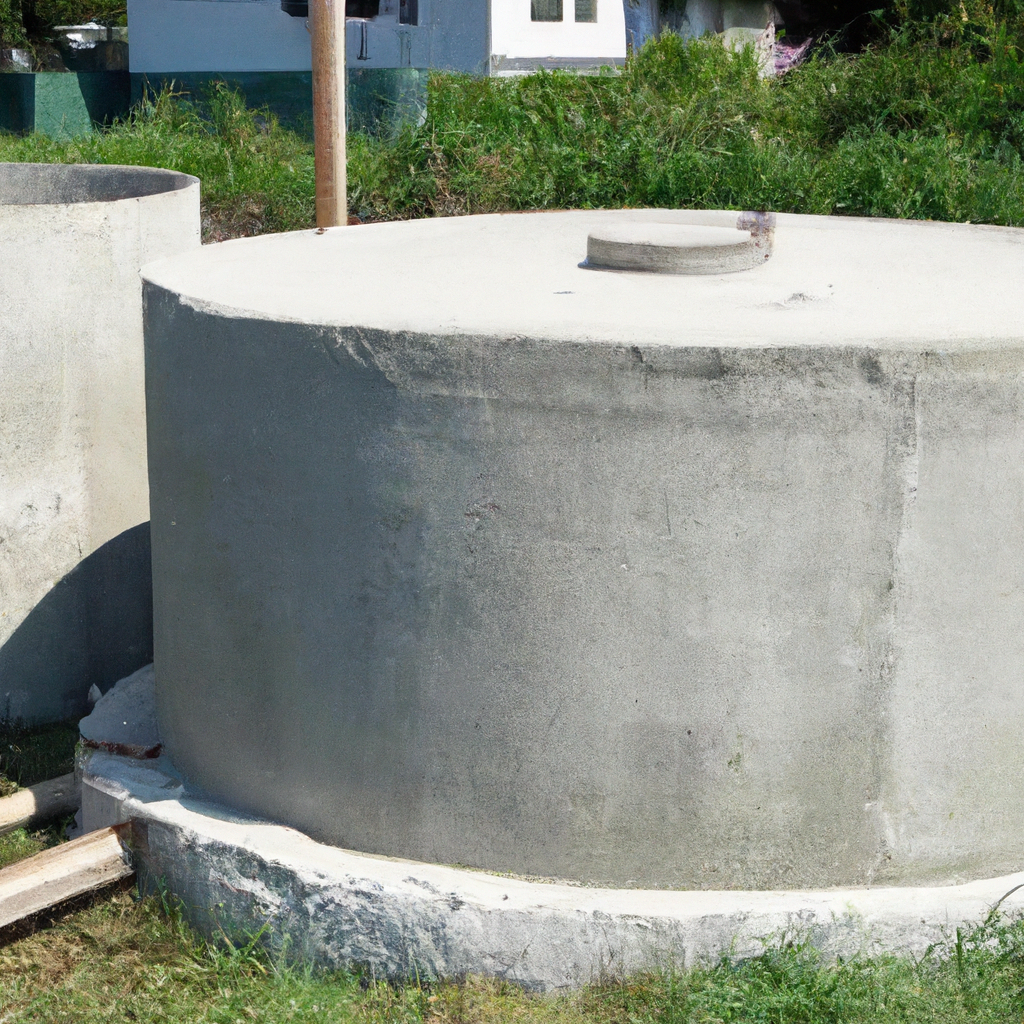If you’ve ever wondered about the appearance of a concrete septic tank, you’re in the right place. In this article, we will take a closer look at what a concrete septic tank actually looks like. From its size and shape to its distinctive features, you’ll gain a clear understanding of this vital component of a septic system. So, let’s explore the world of concrete septic tanks and unravel the mystery behind their appearance.
Understanding Septic Systems
Septic systems are an integral part of many homes, providing a safe and efficient way to manage wastewater. If you are a homeowner or considering purchasing a property with a septic system, it is important to understand how they work and the different types available.
Basics of Septic Systems
A septic system is an underground wastewater treatment system that is used when a property is not connected to a municipal sewer line. It consists of three main components: a septic tank, a distribution box, and a drainfield. These components work together to ensure the proper treatment and disposal of wastewater.
Different Types of Septic Systems
Septic systems come in various types, each differing in terms of design, materials used, and functionality. The most common types include aerobic systems, mound systems, and concrete systems. In this article, we will focus on concrete septic systems and explore their features and characteristics.
Features of a Concrete Septic Tank
Concrete septic tanks are a popular choice due to their durability and longevity. Here are some key features of concrete septic tanks:
General Appearance
Concrete septic tanks are usually rectangular or cylindrical in shape and are buried underground to ensure proper wastewater treatment. The tank’s exterior is made of high-quality concrete, which provides the necessary strength and stability.
Materials Used
As the name suggests, concrete septic tanks are primarily made of concrete. The concrete used is specially designed to withstand the harsh conditions inside the tank, including the presence of wastewater and the pressure exerted by the soil.
Overall Tank Size
The size of a concrete septic tank can vary depending on the needs of the property. Typically, residential concrete septic tanks range from 1,000 to 1,500 gallons in capacity. However, larger tanks are available for commercial or industrial use.

Distribution Box and Drainfield Attributes
In addition to the septic tank, a concrete septic system includes a distribution box and a drainfield. These components play crucial roles in the proper functioning of the system.
Position in Relation to Tank
The distribution box is strategically placed between the septic tank and the drainfield. Its purpose is to evenly distribute the effluent (treated wastewater) throughout the drainfield, allowing for efficient filtration and proper absorption into the surrounding soil.
Functional Importance
The distribution box ensures that the effluent is evenly distributed across the entire drainfield. This prevents overloading of a single area or the drainfield, which can lead to inefficient wastewater treatment and potential system failure.
What to Expect in Concrete Septic Systems
Concrete septic systems are known for their effectiveness and reliability. With proper maintenance and care, these systems can last for several decades. It is important to understand the components and their functions to ensure the system operates optimally.
Components of a Concrete Septic Tank
Concrete septic tanks consist of several key components that work together to treat wastewater effectively and efficiently.
Main Compartments
The interior of a concrete septic tank is divided into two or three main compartments. Wastewater flows into the first compartment, where solid waste settles. The partially clarified water then flows into the second compartment, where further settling occurs. In some larger tanks, there may be a third compartment for additional treatment.
Baffles or Outlet Tees
Within the tank, you will find baffles or outlet tees. These structures prevent solids from flowing into the drainfield and help ensure that only clarified wastewater exits the tank. Proper functioning of baffles or outlet tees is crucial for the overall performance of the septic system.
Effluent Filter
Some concrete septic tanks are equipped with an effluent filter. This filter prevents solids from passing through the outlet pipe and entering the drainfield. Regular cleaning and maintenance of the effluent filter are essential to prevent clogging and maintain the system’s proper functioning.

Advantages of Concrete Septic Tanks
Concrete septic tanks offer several advantages that make them a popular choice for homeowners. Let’s explore some of these advantages:
Durability and Longevity
One of the biggest advantages of concrete septic tanks is their durability. When properly maintained, these tanks can last for several decades. Concrete is resistant to corrosion, rust, and degradation, ensuring that the tank withstands the test of time.
Resistance to Buoyancy
Due to their weight and design, concrete septic tanks are highly resistant to buoyancy. The heavy concrete material prevents the tank from floating or shifting during periods of high groundwater or flooding. This stability ensures the integrity and effectiveness of the system.
Maintenance and Repair Aspects
Concrete septic tanks are relatively easy to maintain and repair. Regular pumping and inspection, as well as routine maintenance tasks, can help prolong the lifespan and performance of the tank. Additionally, if repairs are necessary, concrete tanks can be easily accessed and repaired by professionals.
Drawbacks of Concrete Septic Tanks
While concrete septic tanks offer numerous advantages, it is essential to be aware of their drawbacks as well. Here are a few potential drawbacks to consider:
Heavy Weight
Concrete septic tanks are significantly heavier compared to other tank materials, such as plastic or fiberglass. This heaviness can make the installation process more challenging and potentially require additional equipment or manpower.
Potential for Cracking
Over time, concrete tanks may develop cracks due to settling of the soil, shifts in the ground, or the natural aging process. While proper maintenance and care can minimize the risk of cracking, it is important to keep an eye out for any signs of damage and address them promptly.
Risks of Groundwater Pollution
In rare cases, concrete septic tanks may develop leaks or cracks that can lead to groundwater pollution. Regular maintenance and inspections can help identify potential issues early and mitigate the risk of environmental contamination.

Identifying a Concrete Septic Tank
If you are unsure whether you have a concrete septic tank, there are a few ways to identify it. Here are some tips:
Location and Placement
Concrete septic tanks are typically located underground, usually in the backyard of a property. They are positioned between the house and the drainfield, allowing for proper wastewater treatment and disposal. Look for a rectangular or cylindrical structure buried in the ground.
Visual Identifiers
Inspecting the tank’s exterior can provide additional clues. Concrete tanks often have a greyish appearance, with a smooth or slightly textured surface. The tank may also have access ports or lids for pumping and maintenance purposes.
Differentiating from Other Tank Materials
To differentiate between different tank materials, tap on the tank with a solid object. Concrete tanks will produce a distinct hollow sound compared to other materials like plastic or fiberglass.
Maintenance for Concrete Septic Tanks
Maintaining your concrete septic tank is crucial for its proper functioning and longevity. Here are some recommended maintenance practices:
Recommended Service Schedules
Regular pumping and inspection are key to maintaining a concrete septic tank. The frequency of pumping depends on various factors, including the tank’s size, household size, and wastewater generation. As a general guideline, it is recommended to have the tank pumped every 3-5 years.
Common Maintenance Tasks
In addition to pumping, there are other maintenance tasks to consider. These include monitoring water usage, avoiding excessive use of harsh chemicals, and keeping the drainfield clear of obstructions. Regular inspections by a professional can also help identify any potential issues before they escalate.
Handling Repairs
If you encounter any problems or damage to your concrete septic tank, it is essential to seek professional help. Attempting repairs without the necessary expertise may lead to further damage or system failure. Professional septic system service providers have the knowledge and tools to address repairs effectively and ensure the continued functionality of your tank.

Concrete Septic Tank Installation Process
Proper installation of a concrete septic tank is crucial for its long-term performance. Here are some key aspects of the installation process:
Required Permits and Regulations
Before installing a concrete septic tank, it is important to obtain the necessary permits and ensure compliance with local regulations. This process may involve soil testing, engineering assessments, and obtaining proper documentation to ensure the safety and legality of the installation.
Professional Installation Importance
Due to the complexity of septic system installations and the need to adhere to regulations, it is highly recommended to hire a professional for the installation process. Experienced septic system installers have the expertise, equipment, and knowledge to ensure the tank is correctly placed, connected, and integrated into the overall septic system.
What to Expect During Installation
During the installation process, professionals will excavate the area, prepare the site for the tank’s placement, and carefully lower the tank into the ground. Plumbing connections will be made, and the distribution box and drainfield will be installed according to the property’s specifications. The entire process will be overseen by the installer to ensure compliance with industry standards and regulations.
Replacing an Old or Damaged Concrete Septic Tank
Over time, concrete septic tanks may deteriorate or become damaged beyond repair. If you suspect that your tank needs replacement, here are some important considerations:
Signs Your Tank May Need Replacement
Some signs that indicate your tank may need replacement include persistent foul odors, frequent backups or clogs, excessive water pooling in the drainfield, or visible damage to the tank. If you notice any of these issues, it is crucial to have a professional assess your septic system and determine if replacement is necessary.
Selecting a New Tank
When selecting a new concrete septic tank, it is important to consider the size, capacity, and any specific requirements of your property. Consulting with a professional installer can help determine the appropriate tank size and specifications to ensure efficient wastewater treatment and long-term functionality.
Removal and Installation Process
Replacing a concrete septic tank involves removing the old tank, disposing of it properly, and installing the new tank. This process requires excavation around the tank, careful disconnection of plumbing, and proper disposal of the old tank. A professional installer will handle these tasks and ensure that the new tank is seamlessly integrated into the existing septic system.
In conclusion, understanding septic systems, particularly the features and attributes of concrete septic tanks, is vital for homeowners or potential property buyers. Concrete septic tanks offer durability, resistance to buoyancy, and relatively easy maintenance and repair. While they may have some drawbacks, such as their weight and the potential for cracking or groundwater pollution, regular maintenance and professional installation can mitigate these risks. By familiarizing yourself with the components, maintenance requirements, and installation processes, you can make informed decisions regarding your septic system, ensuring its long-term effectiveness and contributing to the overall functionality of your property.

